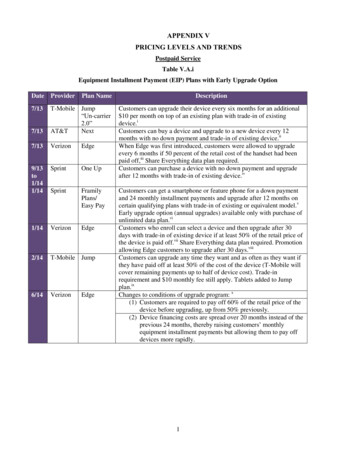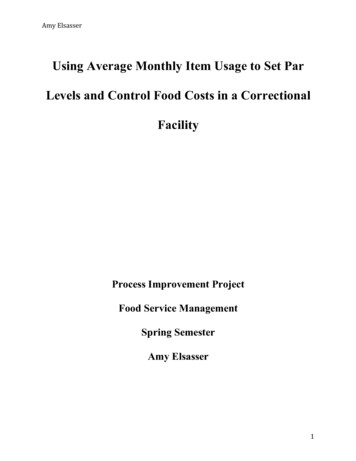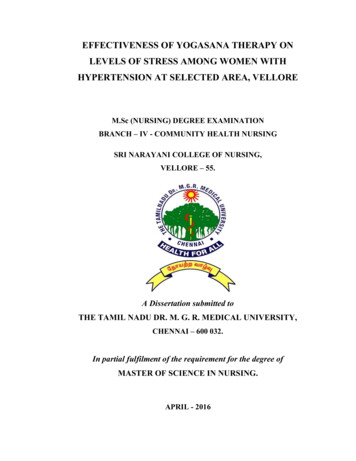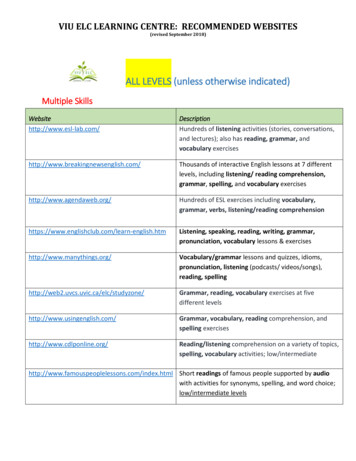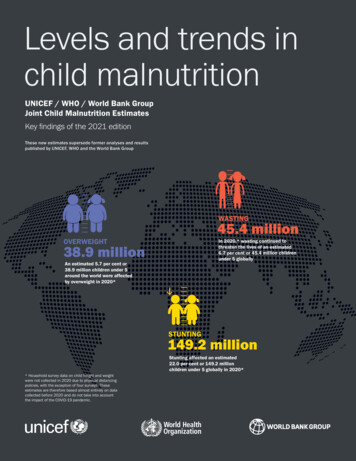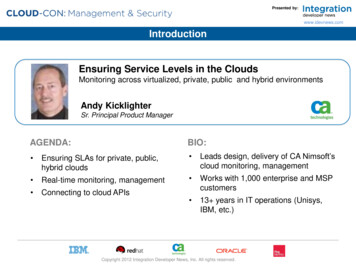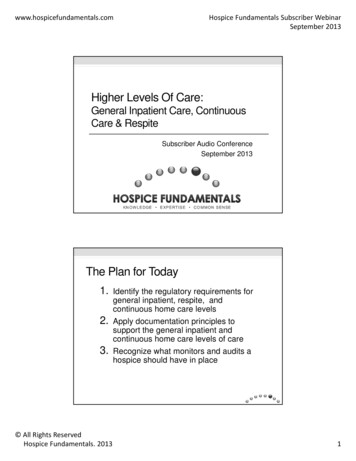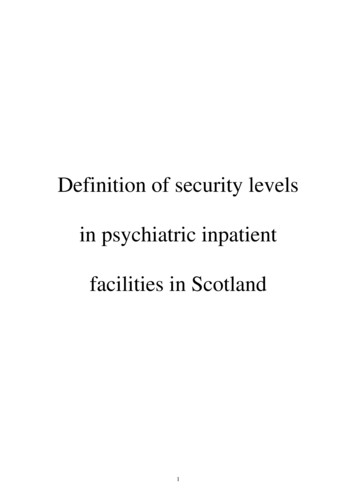
Transcription
Definition of security levelsin psychiatric inpatientfacilities in Scotland1
ContentsPreambleMembership of the Group3Acknowledgements3Terms of Reference4Summary of Work5Chapters1.Introduction to the report62.Literature review83.Defining levels of security in Scotland224.Using the Matrix of Security325.Summary of Conclusions and Recommendations33BibliographyAppendices1. Part 14, Chapter 3 of the Mental Health (Care and Treatment) (Scotland) Act 20032. The 22 items of the Security Needs Assessment Profile (SNAP)2
Membership of the groupChair: Dr John Crichton, Consultant Forensic Psychiatrist, The Orchard Clinic, RoyalEdinburgh HospitalDr Isobel Campbell, Consultant Forensic Psychiatrist, The State HospitalDr Margaret Bremner, Consultant Forensic Psychiatrist, The Blair Unit, Royal CornhillHospital, AberdeenMr Doug Irwin, Security Director, The State HospitalMs Elizabeth Gallagher, Nursing and Operations Manager, The Orchard Clinic, RoyalEdinburgh HospitalMr Kenny McGeachie, Mental Health Strategy Co-ordinator, Scottish Prison ServiceDr John McGinlay, Director of Psychology Services, The State HospitalMs Rosemary Toal, Team Leader, Public Health Division (Restricted patients), ScottishExecutiveDr Tom White, Medical Director, The State Hospital and Forensic Mental Health ServicesManaged Care NetworkFacilitators:Ms Di Douglas, Clinical Effectiveness Facilitator, The State HospitalMs Innes Walsh, Risk Management Facilitator, The State HospitalAcknowledgements:The group are pleased to acknowledge the following people who have made a contribution tothe work of the group and ultimately this report.We were very grateful to Mick Collins, Research Nurse and Chris Ashwell, Security LiaisonNurse from Rampton Hospital for sharing their work on the Security Needs AssessmentProfile and for making the journey to speak to the group on the 7th of May. The group wereimpressed by their research and approach and their visit sparked a lot of useful discussion anddebate.The group acknowledges the contribution made by Ed Finlayson, Head of Social Work, TheState Hospital, South Lanarkshire Council. Ed joined us for our last meeting and advised thegroup from a Social Work and community services perspective.We thank Dave Jago, Head of Publications at The Royal College of Psychiatrists for giving uspermission to reproduce tables from Harry Kennedy’s paper “Therapeutic uses of security:mapping forensic mental health services by stratifying risk” (Advances in PsychiatricTreatment, 8, 433-443)We would also like to thank our colleagues, both those who contributed to informalconsultation about elements of security, and those who offered their support and advice overthe past six months.3
Terms of referenceFollowing the Forensic Mental Health Services Managed Care Network meeting in Stirlingon Tuesday 16 September 2003, Andreana Adamson, Chief Executive of the Network, set upthis expert group to address the question of defining levels of security in psychiatric inpatientsettings. The primary purpose of the group’s work was to contribute to a strategic nationalplanning document on the development of forensic psychiatric services in Scotland.The group was additionally tasked to consider: relevant literature regarding levels of security; whether protocols would be required regarding transfers between different levels ofsecurity; the implications of defining levels of security on the current provision of forensicpsychiatric services; and what developments might be required in the future, including the future role of theState Hospital.The expert group was multi-professional, with representatives from nursing, security, theprison service, the Scottish Executive, psychiatry, social work and psychology. After thegroup’s first meeting the group decided to extend membership to Dr Mark Davidson and MrDoug Irwin; Dr John McGinley stepped down from the group.4
Summary of the work of the groupThe group first met on 3rd December 2003 in Stirling and subsequently met in full on 3occasions including a final meeting on 7th May 2004. Additionally, the chairman and thegroup facilitators met regularly at the State Hospital and the entire group was regularlyupdated and asked for comment between meetings via e-mail. We have informally consultedcolleagues widely about the approach we have taken and obtained details about securitymeasures in a number of settings.A body of background information was prepared by the group facilitators and distributed tothe group; a full bibliography is at the end of this report. In addition, Innes Walsh gave apresentation to group on the topic of needs assessment of mentally disordered offenders. Thechairman interviewed Professor Pamela Taylor, who chairs the Royal College of Psychiatryworking party on security levels. The SNAP project team from Rampton Hospital presentedtheir research on levels of security to the group in Stirling on 7 May.The group considered elements of security which had a possibility of illustrating differencesbetween levels of security. These were drawn from a brainstorming session, with the additionof items from the literature. The group then cross-tabulated the variables against levels ofsecurity and in so doing created a matrix which helps to define inpatient security in Scotland.The final report was submitted to the Forensic Network on 28th May 2004. The Chairmangave oral presentations on the work of the group at Network board meetings on 5th March and4th June 2004. It is planned to present this report at a special meeting organised by theNetwork on 21st June 2004 at Stirling.The report was written in the knowledge that regulations are being prepared in respect ofsections 281-286 of the Mental Health (Care and Treatment) (Scotland) Act 2003 in relationto communication and security. The new Act necessitates the development of statutoryregulations on communications and security and these require to be soundly based andjustifiable. It is foreseeable that as the regulations are developed that standards and practiceswill change and that therefore the current matrix of security is also likely to change. It shouldalso be noted that while the group has delivered on its remit and the following report andrecommendations relate are addressed predominantly to NHS facilities and the State Hospitalin particular, the terms have equal application to all psychiatric public and private inpatientcare.5
CHAPTER ONEIntroduction to the report1.1On 28th January 1999 the Minister for Health in Scotland launched the PolicyDocument “Health, Social Work and related services for Mentally DisorderedOffenders in Scotland”(NHS MEL (1999) 5, Scottish Office 1999) (The MDO Policy).The policy statement examined the provision of mental health and social work servicesand accommodation for mentally disordered offenders (and others requiring similarservices) in the care of the police, prisons, courts, social work department, the StateHospital, other psychiatric services in hospital, and in the community. There were alsoproposals for the organisation and further development of these services throughoutScotland. The MDO policy has subsequently been adopted by the devolvedadministration and continues to be Scottish Executive policy.1.2The Department of Health published the Review of Health and Social Services forMentally Disordered Offenders and others requiring similar services in 1994 (the ReedReport, Department of Health 1994). The Scottish MDO Policy document explicitlyadopted the same set of guiding principles identified by Reed, that mentally disorderedoffenders should be cared for:with regard to quality of care and proper attention to the needs of individuals- as far as possible in the community rather than institutional settings- under conditions of no greater security than is justified by the degree of dangerthey present to themselves or to others- in such a way as to maximise rehabilitation and their chances of sustaining anindependent life- as near as possible to their own homes or families if they have them.1.3The MDO Policy, which was complementary to the Framework for Mental HealthServices in Scotland ((NHS MEL (1997) 62, Scottish Office 1997), tasked HealthBoards with organisation of range of inpatient facilities from the general psychiatricto more specifically forensic, short and longer term and a range of communityoptions. The policy also highlighted the concept of the “managed clinical network”as described by the Acute Services Review report (The Scottish Office, HMSO,1998). This highlighted the need for a formal relationship between components of aservice based on standards of service, quality assurance and seamless provision ofcare.1.4A review of progress of the implementation of the MDO Policy was commissionedfrom the Scottish Development Centre for Mental Health. . The Scottish ExecutiveDepartment of Health in 2001 (NHS, HDL, (2001) 9) published a Care PathwayDocument, which was an outcome of the Scottish Development Centre report andlocal agency received a digest report on progress in their area. The guidance whichaccompanied the care pathway document advocated the establishment of localforensic care forums, which should consider and advise locally on how best toadvance implementation of the MDO Policy; the agencies are invited to report to theScottish Executive annually.1.5In the autumn of 2001 a review group was set up to consider the governance andaccountability of the State Hospital’s Board for Scotland. A consultation paperresulted from that review: “The Right Place, The Right Time” (Scottish Executive2001b). Following consultation, the Forensic Mental Health Services Managed CareNetwork was created in 2003. The Network now has the task of overseeing thedevelopment of services for mentally disordered offenders across Scotland. It willprovide a strategic overview and direction for the planning and development of6
specialist services. It will develop protocols to support the transfer of patientsbetween different levels of service and accommodation and has a potential role indispute resolution.1.6At an early point it became clear that a definition of the different levels of security inpsychiatric care was required to allow strategic planning to take place. Although thisis the primary reason why this group was established, new legislation in Scotlandgave it added importance.1.7In January 2001 the review of the Mental Health (Scotland) Act 1984, chaired by theRight Honourable Bruce Millan, reported to the Scottish Parliament (ScottishExecutive 2001c). The Millan Committee devoted a chapter to high risk patients andrecommended that patients should have a right of appeal to be transferred from theState Hospital or a medium secure facility to conditions of lower security. Thatproposal was adopted in the Mental Health (Care and Treatment) (Scotland) Act2003, Part 17, Chapter 3 (see Appendix I) and is due to be implemented by May 2006.The group was therefore mindful that a definition of different levels of security wouldbe required by Mental Health Tribunals and others to help decide questions ofappropriate security level.1.8At an early stage the group decided not to extend its remit to include consideration ofsecurity within community placements. An important theme emerging within theliterature in England and Wales is the role of community mental health teams inrelation to mentally disordered offenders (Holloway 2002) and in particular therelationship between generic and forensic community services (Buchanan 2002).It is appreciated that for various groups of patients the conditions of lesser securitymay well be made available through the provision of suitable community services.For example there is strong evidence that the needs of many women and also manypatients with a diagnosis of learning disability or other intellectual impairment canbest be met by commissioning services that provide close supervision in thecommunity rather than conditions of security in a hospital environment. Such servicesare likely to reflect the importance of relational security, and appropriately trainedand skilled staff from a variety of backgrounds.The group acknowledge that these aspects of service provision may be addressed inthe current work of the other specialist groups currently reporting on the needs ofwomen and those with a learning disability. Further to this, we recommend to theNetwork that forensic community services, including the use of security, wouldbe an important topic for a future working group1.9One important source of admissions to forensic services is from the Scottish PrisonService, and closer liaison and awareness in both services of each others securityassessments is desirable. In addition, security intelligence should be available toadmitting clinical teams so that a safe level of security can be identified. Werecommend further work be done comparing security assessment in prison andthe Matrix.7
CHAPTER TWOLiterature review2.1A Historical perspective2.1.1Security has always been a feature of psychiatric care. Since the idealistic laws ofPlato (translation by Saunders TJ 1970) there has been identified a responsibility onthose caring for the mentally disordered to prevent them from harming others. Ifcarers failed in this duty then they were liable to pay compensation. There isevidence that this principle was realised in Roman Law (Modestinus). It was notuntil the ‘great confinement’ of the mentally ill (Foucault, 1987) that securitymeasures would become more systematised.2.1.2Mechanical restraint was the mainstay of security in the ‘mad-houses’ of thenineteenth century (Porter), although at an early point the Tuke family at the Retreatnear York popularised the alternative of moral therapy. Even there, mechanicalrestraint was used as a last resort and security was identified as a feature of safe care:‘In the construction of [asylums], cure and comfort ought to be as much consideredas security, and I have no hesita
Chair: Dr John Crichton, Consultant Forensic Psychiatrist, The Orchard Clinic, Royal Edinburgh Hospital Dr Isobel Campbell, Consultant Forensic Psychiatrist, The State Hospital Dr Margaret Bremner, Consultant Forensic Psychiatrist, The Blair Unit, Royal Cornhill Hospital, Aberdeen Mr Doug Irwin, Security Director, The State Hospital Ms Elizabeth Gallagher, Nursing and Operations Manager, The .
